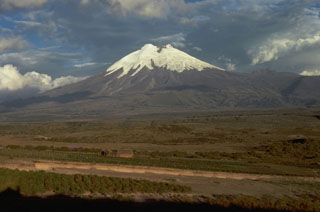Report on Cotopaxi (Ecuador) — 11 January-17 January 2023
Smithsonian Institution / US Geological Survey
Weekly Volcanic Activity Report, 11 January-17 January 2023
Managing Editor: Sally Sennert.
Please cite this report as:
Global Volcanism Program, 2023. Report on Cotopaxi (Ecuador) (Sennert, S, ed.). Weekly Volcanic Activity Report, 11 January-17 January 2023. Smithsonian Institution and US Geological Survey.
Cotopaxi
Ecuador
0.677°S, 78.436°W; summit elev. 5911 m
All times are local (unless otherwise noted)
IG reported that the eruption at Cotopaxi continued during 11-17 January, characterized by daily steam-and-gas emissions often with variable ash content. On 11 January ash plumes rose as high as 200 m above the crater rim and drifted W and SW. Minor ashfall was noted in areas of Mulaló, Macaló Grande, San Antonio, San Ramón (127 km W), Ticatilín (15 km SW), and MAE Norte (18 km N), and a sulfur odor was noted in Ticatilín and Control Caspi (20 km WSW) of the Parque Nacional Cotopaxi. On 12 January steam, gas, and ash plumes rose as high as 1 km and drifted SE, SW, and W. On 13 January a dense ash plume rose 2 km and drifted NE, causing ashfall in Ticatilín; other ash plumes rose 1 km and drifted W and N that same day. Steam-and-gas emissions rose 300-700 m during 14-17 January and drifted E, SE, and SW. Ash-and-gas plumes rose 1 km on 17 January and drifted W and SW; minor ashfall was reported in Mulaló and San Juan de Pastocalle (20 km WSW). Servicio Nacional de Gestión de Riesgos y Emergencias (SNGRE) maintained the Alert Level at Yellow (the second lowest level on a four-color scale).
Geological Summary. The symmetrical, glacier-covered, Cotopaxi stratovolcano is Ecuador's most well-known volcano and one of its most active. The steep-sided cone is capped by nested summit craters, the largest of which is about 550 x 800 m in diameter. Deep valleys scoured by lahars radiate from the summit of the andesitic volcano, and large andesitic lava flows extend to its base. The modern edifice has been constructed since a major collapse sometime prior to about 5,000 years ago. Pyroclastic flows (often confused in historical accounts with lava flows) have accompanied many explosive eruptions, and lahars have frequently devastated adjacent valleys. Strong eruptions took place in 1744, 1768, and 1877. Pyroclastic flows descended all sides of the volcano in 1877, and lahars traveled more than 100 km into the Pacific Ocean and western Amazon basin. Smaller eruptions have been frequent since that time.
Sources: Instituto Geofísico-Escuela Politécnica Nacional (IG-EPN), Servicio Nacional de Gestión de Riesgos y Emergencias (SNGRE)

